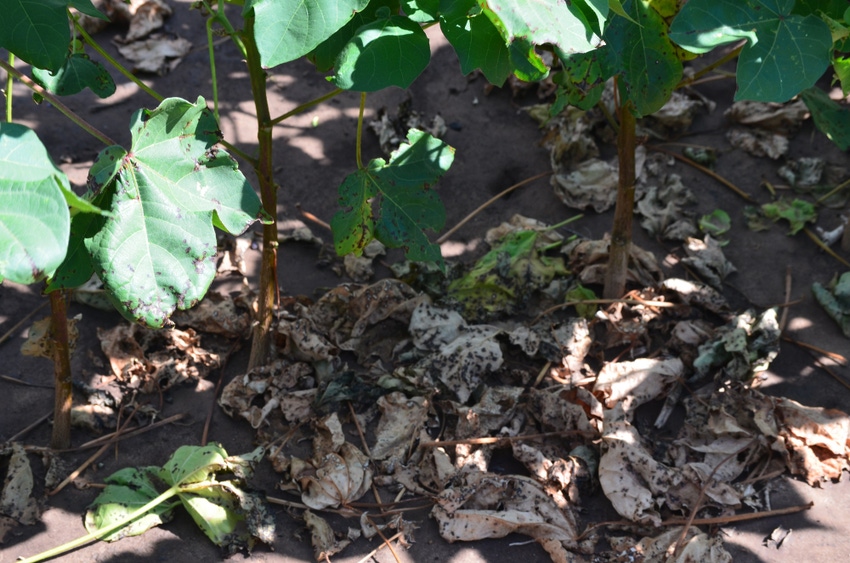
Oklahoma farmers are poised to make one of their best cotton crops ever. The National Agricultural Statistics Service (NASS) estimates place production at 960 pounds per acre, almost 100 pounds higher than last year’s record yield.
Early reports from Southwest Oklahoma gins, Extension specialists, and farmers indicate some irrigated fields closing in on 4 bales per acre, and dryland around 2 bales per acre — all despite a season that started off with weather challenges and included significant losses to bacterial blight in some areas.
Early wet weather delayed planting, pushing some farmers near insurance deadlines to get the crop in. But ample rainfall, including a wetter than usual July, helped make record yields possible.
It also provided a perfect environment for bacterial blight, says Randy Boman, research director at the Oklahoma State University Southwest Research and Extension Center at Altus, and state Extension cotton program leader.
The blight occurred in a year with limited pressure from the usual suspects. “We typically don’t have root knot nematode or Fusarium wilt problems,” Boman says, “and we had very little Verticillium wilt.”
Boman says bacterial blight is not new; it shows up occasionally, and is one of those pathogens that may be around all the time, just looking for the right environment to show itself. It’s not something growers face every year, “and it’s not often a big deal — unless it happens to you.”
For the latest on southwest agriculture, please check out Southwest Farm Press Daily and receive the latest news right to your inbox.
‘IT JUST BLEW UP’
It was a big deal for a significant number of Oklahoma farmers this year, thanks to conditions in July that encouraged the pathogen to thrive. “We’ve generally had some level of the pathogen in some susceptible varieties, but this year it just blew up,” Boman says.
The explosion might have been worse except for “some producers deciding to grow only resistant varieties after localized but significant problems in 2014. This year, the worst fields I have ever seen were where growers planted susceptible varieties and the disease blew up.”
Symptoms began showing up midsummer, Boman says. “July is typically hot and dry — but not this year. We didn’t get the high temperatures and low humidity that we usually see in July.” Rather, conditions developed as something of a perfect storm for bacterial blight: moderate temperatures, high humidity, and plant-damaging wind gusts that moved bacteria from the soil onto plants.
Mesonet data showed July temperatures in the Altus, Okla., area near the long-term average, but August was well below average, and 24-hour average relative humidity was well above normal in July and into August.
“We had a lot of days with average relative humidity above 80 percent, and perhaps greater in plant canopies of irrigated fields,” Boman says. “We had the plant-damaging wind, with gusts over 50 mph on several occasions. Wind blows the pathogen into wounds or the stomata, where it begins to develop and damage the tissue.
More on Cotton
Ample rainfall this season holds good prospects for Okla. cotton
Texas’ top cotton region appears to be having a good 2016
The pathogen may have been biding its time. “Historically, farmers in the area have planted a lot of susceptible varieties, so the pathogen may have been building up.” With ideal conditions, it hit those susceptible varieties in July.
Boman describes bacterial blight as something like “a plant version of flesh-eating bacteria that devours plant tissue. It will move from leaves to bolls, and lesions will penetrate the boll wall, discolor the lint, and trigger boll rot. A serious infection will defoliate plants, destroy some bolls, and reduce the size of other bolls.”
SIGNIFICANT LOSS POSSIBLE
Where the disease is severe, yield loss can be significant, up to a bale per acre or more in some fields. “But we see a lot of variability,” Boman says. “Damage can be a double whammy, with direct boll losses, along with leaf loss that reduces boll size.
“Most dryland fields will not see bacterial blight problems. The canopy is more open, so air flow is greater and humidity is lower. I think we have a lot of good dryland cotton.”
See also.
Altus farmer Clint Abernathy says some of his early-harvested, irrigated, susceptible cotton, suffered significant bacterial blight damage. “Yield loss was variable,” he says. He saw no damage in resistant varieties in irrigated fields, and no significant damage in his dryland cotton.
Boman says he will alert growers about the potential for bacterial blight during winter cotton meetings. “I’ll tell them to look at variety trials and realize that varieties with perhaps moderate to severe damage won’t do as well. Resistant varieties will rise to the top of these trials.”
Bacterial blight was present in every 2016 variety trial but one. He recommends that growers look for resistant varieties for 2017 planting. “Infected plant material can allow the pathogen to carry over from one year to the next.”
In spite of the bacterial blight issue, Boman says, Oklahoma cotton growers are looking at what is likely to be the highest per acre yield in history. “It kinda makes me wonder just what it could have been without the blight.”
About the Author(s)
You May Also Like






